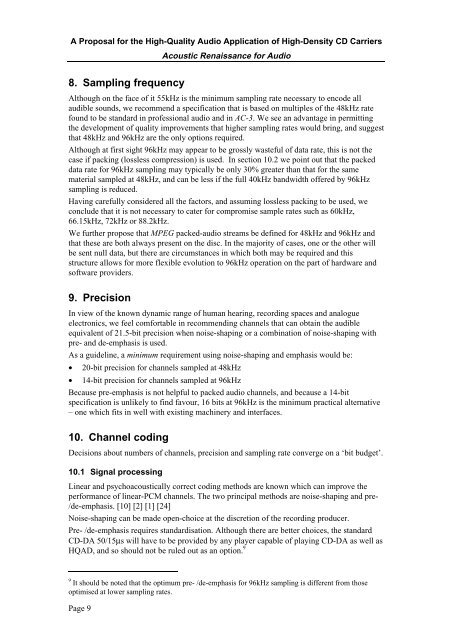A Proposal for the High-Quality Audio Application of High ... - Meridian
A Proposal for the High-Quality Audio Application of High ... - Meridian
A Proposal for the High-Quality Audio Application of High ... - Meridian
Create successful ePaper yourself
Turn your PDF publications into a flip-book with our unique Google optimized e-Paper software.
A <strong>Proposal</strong> <strong>for</strong> <strong>the</strong> <strong>High</strong>-<strong>Quality</strong> <strong>Audio</strong> <strong>Application</strong> <strong>of</strong> <strong>High</strong>-Density CD Carriers<br />
8. Sampling frequency<br />
Page 9<br />
Acoustic Renaissance <strong>for</strong> <strong>Audio</strong><br />
Although on <strong>the</strong> face <strong>of</strong> it 55kHz is <strong>the</strong> minimum sampling rate necessary to encode all<br />
audible sounds, we recommend a specification that is based on multiples <strong>of</strong> <strong>the</strong> 48kHz rate<br />
found to be standard in pr<strong>of</strong>essional audio and in AC-3. We see an advantage in permitting<br />
<strong>the</strong> development <strong>of</strong> quality improvements that higher sampling rates would bring, and suggest<br />
that 48kHz and 96kHz are <strong>the</strong> only options required.<br />
Although at first sight 96kHz may appear to be grossly wasteful <strong>of</strong> data rate, this is not <strong>the</strong><br />
case if packing (lossless compression) is used. In section 10.2 we point out that <strong>the</strong> packed<br />
data rate <strong>for</strong> 96kHz sampling may typically be only 30% greater than that <strong>for</strong> <strong>the</strong> same<br />
material sampled at 48kHz, and can be less if <strong>the</strong> full 40kHz bandwidth <strong>of</strong>fered by 96kHz<br />
sampling is reduced.<br />
Having carefully considered all <strong>the</strong> factors, and assuming lossless packing to be used, we<br />
conclude that it is not necessary to cater <strong>for</strong> compromise sample rates such as 60kHz,<br />
66.15kHz, 72kHz or 88.2kHz.<br />
We fur<strong>the</strong>r propose that MPEG packed-audio streams be defined <strong>for</strong> 48kHz and 96kHz and<br />
that <strong>the</strong>se are both always present on <strong>the</strong> disc. In <strong>the</strong> majority <strong>of</strong> cases, one or <strong>the</strong> o<strong>the</strong>r will<br />
be sent null data, but <strong>the</strong>re are circumstances in which both may be required and this<br />
structure allows <strong>for</strong> more flexible evolution to 96kHz operation on <strong>the</strong> part <strong>of</strong> hardware and<br />
s<strong>of</strong>tware providers.<br />
9. Precision<br />
In view <strong>of</strong> <strong>the</strong> known dynamic range <strong>of</strong> human hearing, recording spaces and analogue<br />
electronics, we feel com<strong>for</strong>table in recommending channels that can obtain <strong>the</strong> audible<br />
equivalent <strong>of</strong> 21.5-bit precision when noise-shaping or a combination <strong>of</strong> noise-shaping with<br />
pre- and de-emphasis is used.<br />
As a guideline, a minimum requirement using noise-shaping and emphasis would be:<br />
• 20-bit precision <strong>for</strong> channels sampled at 48kHz<br />
• 14-bit precision <strong>for</strong> channels sampled at 96kHz<br />
Because pre-emphasis is not helpful to packed audio channels, and because a 14-bit<br />
specification is unlikely to find favour, 16 bits at 96kHz is <strong>the</strong> minimum practical alternative<br />
– one which fits in well with existing machinery and interfaces.<br />
10. Channel coding<br />
Decisions about numbers <strong>of</strong> channels, precision and sampling rate converge on a ‘bit budget’.<br />
10.1 Signal processing<br />
Linear and psychoacoustically correct coding methods are known which can improve <strong>the</strong><br />
per<strong>for</strong>mance <strong>of</strong> linear-PCM channels. The two principal methods are noise-shaping and pre-<br />
/de-emphasis. [10] [2] [1] [24]<br />
Noise-shaping can be made open-choice at <strong>the</strong> discretion <strong>of</strong> <strong>the</strong> recording producer.<br />
Pre- /de-emphasis requires standardisation. Although <strong>the</strong>re are better choices, <strong>the</strong> standard<br />
CD-DA 50/15μs will have to be provided by any player capable <strong>of</strong> playing CD-DA as well as<br />
HQAD, and so should not be ruled out as an option. 9<br />
9<br />
It should be noted that <strong>the</strong> optimum pre- /de-emphasis <strong>for</strong> 96kHz sampling is different from those<br />
optimised at lower sampling rates.


